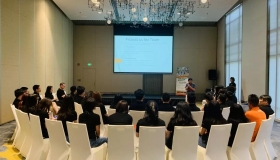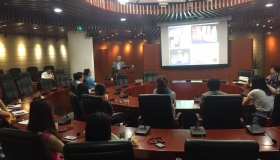CUHK-Shenzhen Researchers Reveal Exotic Dynamics of Frustrated Magnetic Skyrmions and Antiskyrmions
The 2016 Nobel Prize in Physics was awarded to three theoretical physicists for their discoveries of topological phase transitions and topological phases of matter, which highlights the role and significance of topology in understanding the physical world. In the field of magnetism, topology is also directly related and fundamental to the physics of an exotic magnetic texture, namely, the magnetic skyrmion.
Magnetic skyrmions are nanoscale magnetic structures with topological quantum numbers, which exist in a number of materials and can be controlled by different reliable methods such as electric current and others. Due to the nanoscale size and topologically protected stability, magnetic skyrmions hold great promise in spintronic applications such as magnetic memories and logic computing devices. In order to manipulate magnetic skyrmions for information processing, it is essential to fully understand the dynamics of magnetic skyrmions.
Recently, the Applied Spintronics Lab of the Chinese University of Hong Kong, Shenzhen and collaborators from Shenzhen University, Shinshu University, and the University of Tokyo have studied the magnetic skyrmions in frustrated magnets and revelled the exotic dynamics of frustrated magnetic skyrmions, which is totally different from that of magnetic skyrmions in common ferromagnetic materials. They found the helicity locking-unlocking transition of frustrated magnetic skyrmions by including dipole-dipole interactions in their theoretical model, which is an energy term usually negligible for common ferromagnetic skyrmions. In the frustrated magnets, the researchers point out that the dipole-dipole interaction plays an important role in the helicity-orbital coupling of the skyrmion, especially at low temperature. In addition, the researchers show that the current-controlled skyrmions and antiskyrmions dynamics with locking-unlocking helicity in frustrated magnets can enable novel spintronic applications such as the helicity-based information storage devices.

The discovery is reported this week in the prestigious journal Nature Communications, in a paper by CUHK(SZ) research assistant Xichao Zhang, and Ph.D. student Jing Xia, and four others from Shenzhen University, China, Shinshu University, Japan, and the University of Tokyo, Japan.
“Helicity is a degree of freedom of frustrated magnetic skyrmions,” says Xichao Zhang, the first author of the study. “In conventional ferromagnetic materials, the helicity of a skyrmion cannot be effectively controlled, while we find it is possible to control the skyrmion helicity by utilizing the helicity locking-unlocking transition in frustrated magnetic materials,” Zhang adds that the control of helicity can lead to novel spintronic applications such as the helicity-based skyrmionic memories.
“Our study also shows the interactions between frustrated skyrmions and antiskyrmions, which are problems of both theoretical and practical significance,” explains Yan Zhou, associate professor of CUHK(SZ). Prof. Zhou says, it is also possible to build logic computing devices based on skyrmions and antiskyrmions, and his group is pursuing this currently. This research project was financially supported by the National Natural Science Foundation of China, the President’s Fund of the Chinese University of Hong Kong, Shenzhen, the Shenzhen Fundamental Research Fund of the Shenzhen Science and Technology Innovation Commission, and the Longgang District Government. Prof. Zhou also adds the research projects carried out in CUHK(SZ) are also strongly supported by university and department leaders, administrators, and technicians. The international cooperation platform provided by the university is beneficial for all researchers and students to obtain collaborative research outputs.
During this year, the CUHK(SZ) Applied Spintronics Lab has also published two skyrmion-related research papers in New Journal of Physics and Journal of Applied Physics. The paper published in New Journal of Physics by Xichao Zhang et al. is a collaborative output of CUHK(SZ) and the University of Cologne, Germany, the Dresden University of Technology, Germany, and the Shinshu University, Japan, which reports the physics of skyrmion-spin wave interactions. The other paper published in Journal of Applied Physics by Jing Xia et al. is a collaborative output of CUHK(SZ) and Beihang University, China, and Shinshu University, Japan, which reports a skyrmion-based microwave application. The research achievements made by the CUHK(SZ) Applied Spintronics Lab will be useful for building future information and big data processing devices, such as non-volatile in-memory computing devices.
Journal References
X. Zhang et al., Skyrmion dynamics in a frustrated ferromagnetic film and current-induced helicity locking-unlocking transition, Nature Communications 8, 1717 (2017). DOI: 10.1038/s41467-017-01785-w.
X. Zhang et al., Motion of skyrmions in nanowires driven by magnonic momentum-transfer forces, New Journal of Physics 19, 065001 (2017). DOI: 10.1088/1367-2630/aa6b70.
J. Xia et al., A microwave field-driven transistor-like skyrmionic device with the microwave current-assisted skyrmion creation, Journal of Applied Physics 122, 153901 (2017). DOI: 10.1063/1.4999013.




